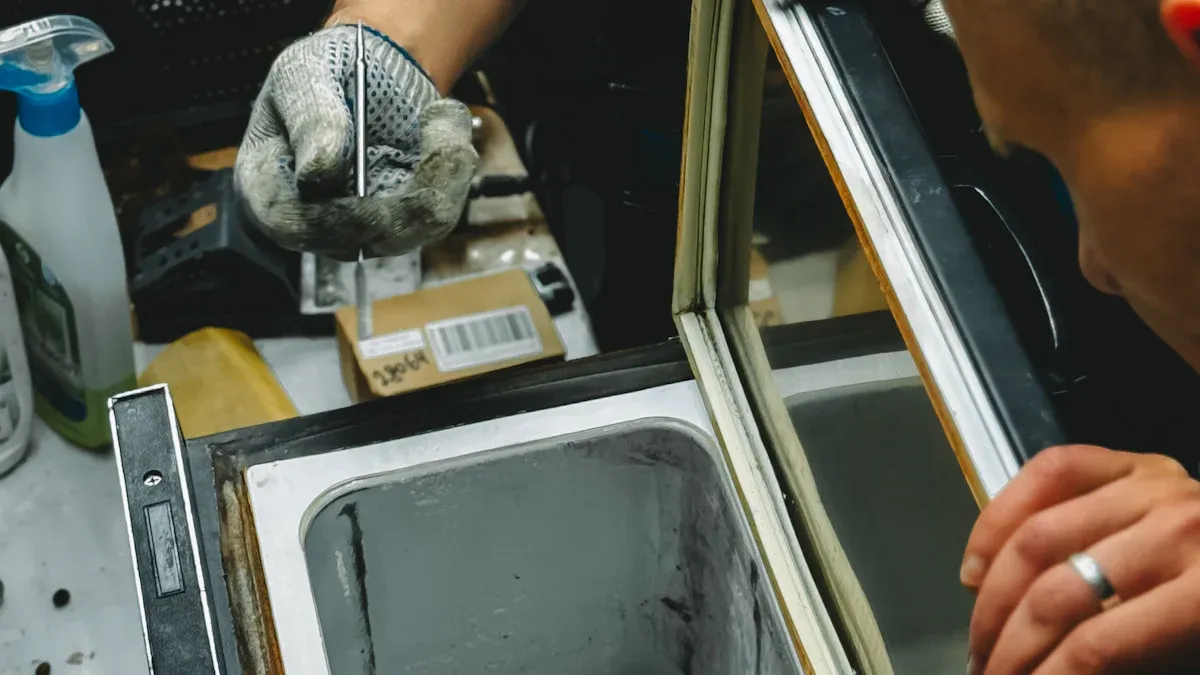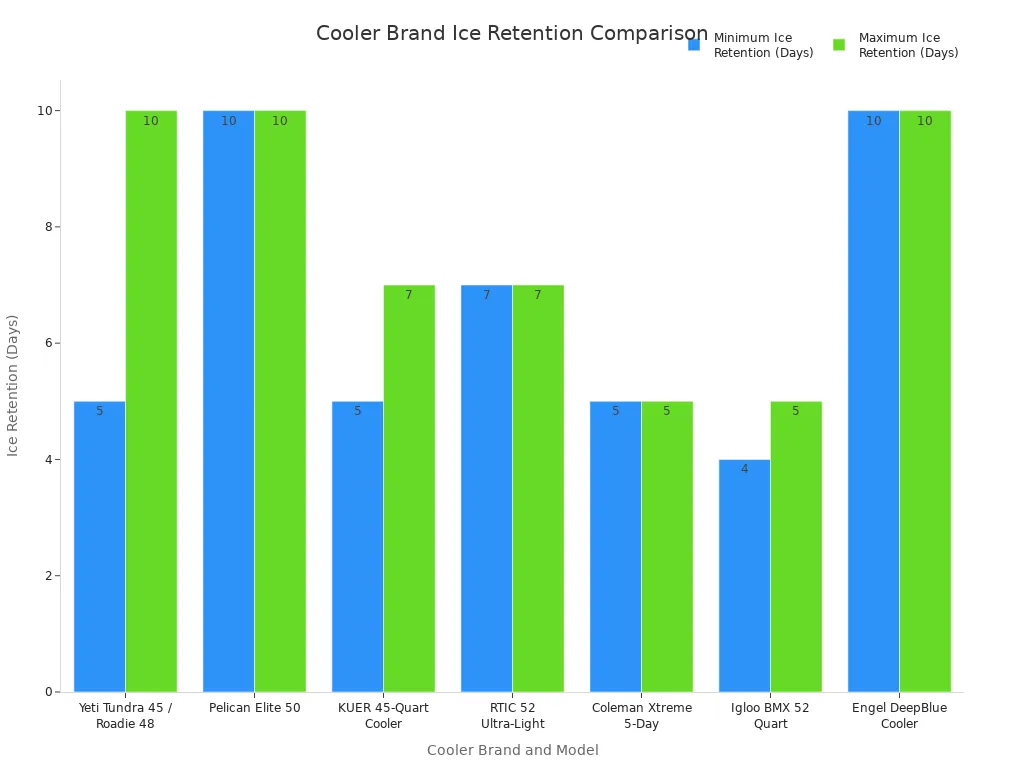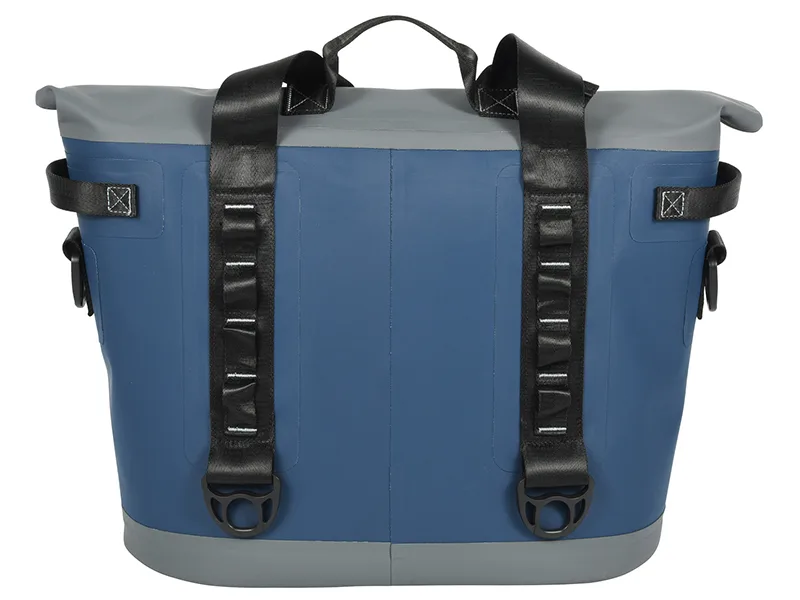

You want your collapsible cooler bag for travel to last through countless adventures. The secret is simple routine care. Mastering a few key practices is the best way to prevent odors, stains, and damage. You can ensure your cooler is always ready for your next journey by focusing on these three essential habits:
- Consistent cleaning after each trip
- Proper drying and storage
- Gentle handling and use
This simple approach guarantees your cooler remains a reliable companion. 🗺️
Key Takeaways
- Clean your cooler bag after every trip. Use mild soap and water for a quick wipe-down. This stops smells and stains.
- Dry your cooler bag completely before storing it. Leave it open in a well-aired spot. This prevents mold and bad smells.
- Store your cooler bag in a cool, dry place. Do not stack heavy things on it. This keeps its shape and insulation safe.
- Handle your cooler bag gently. Do not overfill it. Protect the inside from sharp items. This prevents damage and leaks.
How to Clean a Cooler Bag: Your First Step to Longevity

A clean cooler is a happy cooler. Spills and moisture are inevitable, but letting them sit is what causes odors, mold, and permanent stains. Learning how to clean a cooler bag properly is the most important skill for extending its life. Let’s walk through the simple steps, from a quick wipe-down to a deep clean.
The Simple Post-Trip Wipe-Down
Your first line of defense is a quick clean after every single use. Don’t put it off! This five-minute task prevents most problems before they start.
- Empty the Cooler: Take everything out, including any leftover ice or water.
- Wipe the Interior: Use a soft cloth or sponge with a simple solution of mild dish soap and warm water. Most modern cooler bags use liners that are easy to clean. Materials like PEVA are popular because they are waterproof and wipe clean effortlessly.
- Rinse and Dry: Wipe the interior again with a cloth dampened with plain water to remove any soap residue. Finally, use a dry towel to soak up as much moisture as possible.
Pro Tip: Always leave your cooler bag open to air-dry completely before storing it. This simple step is the best way to prevent mold and musty smells.
Understanding your cooler’s liner can help you clean it effectively. Different materials have unique properties.
| Liner Material | Insulation | Durability | Moisture Resistance | Food Safety |
|---|---|---|---|---|
| PEVA | Excellent | Good | Excellent | High |
| Aluminum Foil | Excellent | Fair | Excellent | High |
| Nylon | Fair | Excellent | Good | High |
| Polyester | Good | Excellent | Good | High |
How to Clean a Soft Cooler with Stubborn Stains
Did a soda explode or a container leak? Don’t worry. You can tackle stubborn food and drink stains with a little extra effort. For this, you’ll want to use natural cleaning agents that are tough on grime but gentle on your cooler’s fabric.
Your go-to solution is a simple paste made from baking soda and water. Here’s how to clean a soft cooler and make it look new again:
- Create a Paste: Mix a few tablespoons of baking soda with just enough water to form a thick paste.
- Apply to the Stain: Gently rub the paste onto the stained area with a soft-bristled brush or a cloth.
- Let It Sit: Allow the paste to sit for at least 15-20 minutes. The baking soda will work to lift the stain and neutralize any odors.
- Scrub and Rinse: Gently scrub the area again, then wipe it clean with a damp cloth. Repeat if the stain is particularly tough.
This method is a fantastic part of knowing how to clean a cooler bag because it avoids harsh chemicals that could damage the liner.
Deep Cleaning Methods for a Fresh Start
Sometimes, your cooler needs a reset. A deep clean is perfect for eliminating lingering odors or tackling mildew that appeared during storage. This process uses two powerhouse cleaning supplies you probably already have: white vinegar and baking soda.
For Disinfecting and Odor Removal: White vinegar is a natural disinfectant that kills bacteria and neutralizes funky smells.
- Mix a solution of equal parts white vinegar and warm water in a spray bottle.
- Spray the entire interior of the cooler bag.
- Let the solution sit for about 15 minutes, then wipe it down thoroughly with a clean, damp cloth.
For Deodorizing and Mildew: If you have a really persistent smell, baking soda is your best friend.
After cleaning with vinegar, you can place an open box or a wide bowl of dry baking soda inside the cooler. Close the lid and leave it for a day or two. The baking soda will absorb any remaining odors.
This two-step approach is the ultimate answer for how to clean a cooler bag that needs a fresh start. It ensures your bag is not just visibly clean but also hygienic and ready for your next trip.
Can You Machine Wash Your Cooler Bag?
This is a great question, and the short answer is: it depends. Tossing your cooler bag into the washing machine might seem like an easy fix, but it can be a risky move. Before you do, you need to check the manufacturer’s care label. Most cooler bags are not designed for machine washing.
⚠️ Warning: Always check the care tag first! If it says “hand wash only” or “spot clean,” putting it in the machine could ruin the insulation, damage the waterproof liner, or cause the seams to fall apart.
Machine washing can introduce several problems. You should be aware of these risks before deciding how to clean a cooler bag.
- Risk of Damage: The tumbling action of a washing machine can be too rough. It might tear the liner, weaken the seams, or damage the insulation that keeps your food and drinks cold.
- Fading Colors: The combination of detergent, water, and agitation can make the vibrant colors of your bag fade, especially after a few washes.
- Lingering Odors: Surprisingly, a machine wash doesn’t always get rid of strong smells. Odors can get trapped in the materials and might not wash out completely.
So, what if you really want a machine-washable option? Some brands do make them. For example, you might find a product like the Midday Quilted Washable Insulated Lunch Bag. These are specifically designed to handle a machine wash. They often use materials like poly taffeta fabric with a PEVA liner, which are durable enough for a gentle cycle.
If your cooler bag is confirmed to be machine washable, follow these steps for the best results:
- Prepare the Bag: Empty it completely and pre-treat any major stains using the baking soda paste method we discussed earlier.
- Use a Gentle Cycle: Select the delicate or gentle cycle on your washing machine.
- Use Cold Water: Always use cold water to protect the fabric and insulation.
- Air-Dry Only: Never put your cooler bag in the dryer. The high heat will destroy the insulation and can melt the liner. Hang it up to air-dry completely.
Ultimately, hand-washing is the safest and most effective method for how to clean a cooler bag. It gives you full control and protects the materials that make your cooler work. While machine washing is convenient, it’s a gamble unless the manufacturer explicitly says it’s okay. Sticking to the hand-washing techniques for how to clean a cooler bag ensures it stays in top shape for years of travel.
Proper Drying and Storage to Prevent Mold and Damage
Cleaning your cooler is only half the battle. How you dry and store it is just as important for its longevity. Skipping these steps can lead to musty smells, mildew growth, and even permanent damage to the insulation. Let’s make sure your cooler is stored correctly so it’s always ready for action.
The Importance of Air-Drying Completely
You must dry your cooler bag completely after every cleaning. This is the single best way to prevent mold and mildew. Mold is a type of fungus, and it needs moisture to grow. When you eliminate the water, you eliminate the problem.
After wiping it down, simply leave your cooler open in a well-ventilated area. Let air circulate until the interior and exterior are 100% dry to the touch. This simple habit scientifically prevents mold from ever getting a start.
Smart Storage for Your Collapsible Cooler Bag for Travel
Finding the right storage spot keeps your cooler safe. You should store your bag in a cool, dry place away from direct sunlight. Closets, pantries, or garage shelves are great options. This environment prevents heat or humidity from degrading the materials over time.
Some modern coolers are designed for smart storage. For example, certain models can transform from a cube into a flat, one-inch-thick profile. This makes them incredibly easy to slide under a bed, into a car trunk, or within tight RV compartments.
Preserving Insulation and Shape While Stored
How you place your cooler in storage matters. You want to protect its insulation and structure. Severe compression can permanently crush the tiny fibers inside the insulation, which reduces its ability to keep things cold.
Follow these simple rules to protect your collapsible cooler bag for travel:
- Avoid Stacking: Never place heavy objects on top of your cooler. This can crush its shape and damage the insulation.
- Store it Loosely: Avoid folding or stuffing the bag tightly into a small space. This puts stress on the seams and insulation fibers.
- Keep its Shape: Store the bag flat or standing upright whenever possible. This helps maintain its structure and ensures the insulation isn’t compromised.
Gentle Handling and Smart Usage Tips for Travel

Your cooler is built for adventure, but a little smart handling goes a long way. How you pack and use your bag on the road is just as crucial as cleaning and storing it. These simple habits will protect your cooler from physical damage and keep it functioning perfectly.
Avoid Overloading Zippers and Seams
You might be tempted to stuff your cooler to the brim, but this is a major cause of wear and tear. Overloading your bag puts too much stress on its structure. Look for signs of strain like fraying threads around the seams or a zipper that struggles to close. Pushing your cooler past its limits can cause seams to split and zippers to break, leaving you with a mess. Always pack your collapsible cooler bag for travel with a little room to spare. This protects the zippers and seams, ensuring they hold up for many trips to come.
Protecting the Interior Liner from Punctures
The waterproof interior liner is the heart of your cooler. A puncture can lead to leaks and ruin the insulation. You can easily prevent this by being mindful of what you pack.
- Avoid placing sharp objects like forks, knives, or loose keys directly inside.
- Use food containers with rounded edges instead of sharp corners.
- Consider using a protective accessory. Heavy-duty, peel-and-stick plastic liners are a great option. They add a tough layer of defense inside your cooler.
One frequent user described these liners as “very heavy duty and tough as hell,” highlighting how effective they are at preventing damage from regular use.
Essential Zipper Care and Maintenance
A stuck or broken zipper can make your cooler useless. Keeping your zipper clean and lubricated is a quick task that prevents frustration. After cleaning your bag, make sure the zipper track is free of sand, dirt, and sticky residue. If the zipper feels stiff, a little lubricant can make it glide smoothly again.
Here are a few great options for lubricating your cooler’s zipper:
- Glycerin: This option is non-toxic and washes away easily with water.
- RTIC Soft Pack Zipper Lubricant: A product made specifically for cooler zippers.
- Toilet bowl wax ring: A simple, effective, and waterproof solution.
- Non-toxic lubricant for plastic: You can often find this at pool supply stores.
A smooth zipper makes accessing your food and drinks effortless and extends the life of your bag.
Pro Tips for Peak Performance and Durability
Beyond cleaning and storage, a few pro habits can boost your cooler’s performance and make it last even longer. These simple tricks ensure you get the coldest drinks and the most use out of your bag.
Pre-Chilling Your Cooler for Better Efficiency
You can give your cooler a head start and make your ice last longer with a simple pre-chilling trick. The day before your trip, fill your cooler bag with a mixture of ice and cold water. This brings the internal temperature way down. Right before you pack your food and drinks, just pour the ice water out. This method works great for any cooler and ensures it starts cold, so it stays cold. 🧊
Using Ice Packs vs. Loose Ice
Choosing between ice packs and loose ice can make a big difference in cleanliness and convenience. While loose ice works, ice packs and gel packs offer some great advantages.
- They often keep things cold for several days, much longer than ice cubes.
- They don’t melt into a watery mess, which keeps your food dry and your car clean.
- Gel packs provide very consistent cooling because of their low thermal conductivity.
Note: Using ice packs prevents water leakage, which makes cleanup much easier and protects your cooler’s interior from sitting in water.
Choosing the Right Cooler: A Look at KUER Options
The best way to ensure longevity is to start with a durable, high-performance cooler. KUER coolers are a standout choice, designed with over a decade of expertise in outdoor goods. They use advanced manufacturing techniques like rotational molding to create incredibly rugged products.
KUER soft coolers are built to handle tough conditions with features like:
- High-density, waterproof, and stab-proof fabric
- Adjustable shoulder straps and double handles for easy carrying
- A large interior space perfect for camping or family trips
When it comes to performance, KUER holds its own against top brands. Thanks to their robust, rotomolded construction, they can withstand drops and heavy use.
| Cooler Brand/Model | Ice Retention Duration | Durability Notes |
|---|---|---|
| Yeti Tundra 45 / Roadie 48 | 5-10 days | Premium build, trusted by outdoor experts, highly durable roto-molded design |
| Pelican Elite 50 | Up to 10 days | Heavy-duty, lifetime warranty, military-grade, rotomolded shell |
| KUER 45-Quart Cooler | 5-7 days | Rugged, advanced manufacturing, patented technology, robust build, rotomolded construction |
| RTIC 52 Ultra-Light | Up to 7 days | High performance at lower price, durable with heavy-duty wheels and handles |
| Coleman Xtreme 5-Day | Up to 5 days | Lightweight, budget-friendly, classic, lighter build |
While some premium brands may offer slightly longer ice retention, KUER provides a fantastic balance of durability and solid 5-to-7-day ice performance, making it a reliable investment for any adventurer.

Your cooler’s lifespan really comes down to three core actions. Knowing how to clean a cooler bag is the first step. You also need to dry and store it correctly and handle it with care. Making these simple steps a habit guarantees your collapsible cooler bag for travel remains a reliable companion for years. A well-maintained bag isn’t just an accessory; it’s your ticket to fresh food and cold drinks on any adventure. 🏞️
FAQ
How do I get rid of a really funky smell?
For a really tough smell, try activated charcoal. After cleaning your bag, place a charcoal deodorizer inside. Close the bag for a day or two. The charcoal will absorb any lingering odors, leaving your cooler fresh and ready for use.
Can I use bleach to clean my cooler bag?
You should avoid using bleach. Harsh chemicals like bleach can damage the waterproof liner and cause the fabric to break down over time. Stick to gentle cleaners like dish soap, baking soda, and vinegar for the best results.
What’s the best way to pack my cooler to prevent damage?
You can protect your cooler‘s liner by packing smart. Place drinks and hard containers on the bottom. Put softer food items on top. This simple step prevents sharp corners from puncturing the interior and causing leaks. 🥪
How long should my cooler bag last?
A quality cooler bag can last for many years with proper care. Your habits make the biggest difference. By cleaning, drying, and handling it correctly after each trip, you ensure it remains a reliable travel partner for countless adventures.




